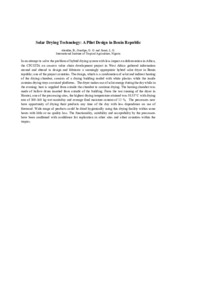| dc.contributor.author | Alenkhe, E.B. |
| dc.contributor.author | Onadipe, O.O. |
| dc.contributor.author | Sanni, L.O. |
| dc.date.accessioned | 2019-12-04T11:07:59Z |
| dc.date.available | 2019-12-04T11:07:59Z |
| dc.date.issued | 2012-02 |
| dc.identifier.citation | Alenkhe, E.B., Onadipe, O.O. & Sanni, L.O. (2012). Solar drying technology: a pilot design in Benin Republic. In: Proceedings of the 11th triennial Symposium of the International Association of Hydrological Sciences held at Memling Hotel: Tropical roots and tuber crops and the challenges of globalization and climate changes, (pp. 519-522), Kinshasa, 4-8 October. Ibadan: ISTRC-AB. |
| dc.identifier.uri | https://hdl.handle.net/20.500.12478/1677 |
| dc.description.abstract | An appropriate drying system remains a critical factor for the development of cassava enterprises in Africa, most especially at the rural sector. As part of solving this problem, the Cassava value chain development in West Africa - a project sponsored by the Common Fund for Commodities source information on existing solar drying systems in Nigeria, Ghana, Uganda,
Cameroon, and Sierra Leone. Findings from the survey assisted in the design and fabrication of an hybrid solar drying system with less impact on deforestation. The dryer was installed in Hounvi village in Benin republic; one of the project countries. The design, which is a combination of solar and indirect heating of the drying chamber, consists of a drying building roofed with white plastics while the inside contains drying trays on raised platforms. The dryer make use of solar energy during the day while in the evening; heat is supplied from outside the chamber to continue drying. The heating chamber was made of hollow
drum inserted from outside of the building. The highest drying temperature attained was 58.55oC with a drying rate of 100-160 kg wet mash/day and an average final moisture content of 11 %. The processors now have opportunity of drying their products any time of the day with less dependence on use of firewood. Wide range of products could be dried hygienically using this drying facility within some hours with little or no quality loss. The functionality, suitability and acceptability by the processors have been confirmed with confidence for replication in other sites and other countries within the tropics. |
| dc.description.sponsorship | Common Fund for Commodities |
| dc.format.extent | 519-522 |
| dc.language.iso | en |
| dc.publisher | International Association of Hydrological Sciences |
| dc.subject | Cassava |
| dc.subject | Value Chain |
| dc.subject | Drying |
| dc.subject | Solar Energy |
| dc.subject | Drying Technology |
| dc.title | Solar drying technology: a pilot design in Benin Republic |
| dc.type | Conference Proceedings |
| cg.contributor.crp | Roots, Tubers and Bananas |
| cg.contributor.affiliation | International Institute of Tropical Agriculture |
| cg.coverage.region | Africa |
| cg.coverage.region | West Africa |
| cg.coverage.country | Benin |
| cg.authorship.types | CGIAR single centre |
| cg.iitasubject | Cassava |
| cg.iitasubject | Post-Harvesting Technology |
| cg.iitasubject | Value Chains |
| cg.howpublished | Formally Published |
| cg.publicationplace | Ibadan, Nigeria |
| cg.accessibilitystatus | Limited Access |
| local.dspaceid | 82849 |
| cg.targetaudience | Scientists |


